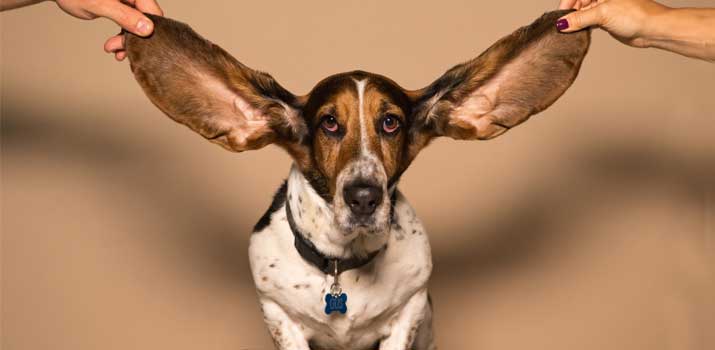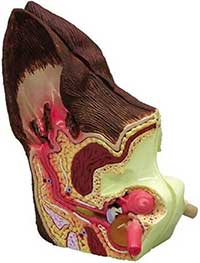Most dog owners go to great lengths to keep their pooch smelling fresh. But even still, canines have a reputation for being stinky creatures!
Dealing with strange smells comes with the territory of raising a dog. While we learn to deal with all those musky aromas as they come, some scents tend to stand out more than others.
One of the most alarming and puzzling is a stench that comes from the ears.

Smelly ears are not something you should ignore. Your dog's ears are like a small, delicate habitat. Hiding behind the expressive movement is a slew of sensitive structures that respond to changes in moisture, humidity levels, and more.
When things go out of whack in your dog's ears, they're bound to experience pain, discomfort, and irritation. Smells are just one of the ways that you can tell that something is amiss.
Canine Ear Anatomy
Whether your pooch has triangular ears or big-old floppers that hang low next to its face, the anatomy of this organ is complex. The easiest way to look at the ear is to think of it as three separate sections.

The first is the external ear, which is sometimes referred to as the pinna. The pinna is the part that we see. It acts as a protective covering meant to keep the other two parts, the middle and inner ear, safe.
The middle and inner ear contains sensitive blood vessels, balancing organs, and more. Those inner workings are easy to damage, so the pinna covers it all to minimize issues.
Unfortunately, the pinna doesn't always work like it's supposed to. You see, your dog's ear is like a petri dish for bacteria, fungi, and pathogens to flourish.
It doesn't take much for infections to occur. When the pinna isn't able to keep invaders out, smells and other issues will arise.
7 Common Causes for Smelly Dog Ears
The severity of the stench can vary depending on the root cause. Sometimes, it's a sweet smell that some compare to candy or caramel. In other instances, it can be pungent like rotting meat or cheese!
Whatever the case may be, don't ignore the smell! It could be a sign of severe health problems that you need to address.
Here are some of the most likely causes for your dog's smelly ear issue and what you can do to provide relief.
#1. Wax Buildup
A little bit of ear wax is a good thing for dogs. It provides some protection by trapping dust and foreign particles from entering the inner ear. However, there's a limit to how much wax your dog should have in its ears!
Too much of it can attract odor-causing bacteria. Some dogs produce more wax than others, so it's important to stay on top of ear-cleaning duties.
What you can do:
There are many products out there to help remove wax. Veterinarians don't recommend using cotton swabs or any other tool. Instead, go for wax-dissolving flushes.
They're easy to use and will take care of accumulated wax without any issues.
#2. Bacterial Infections
Bacterial infections are more common than dog owners think.
In most cases, infections are caused by excess moisture. Your dog might exhibit symptoms several days after getting a bath or going for a swim.
That extra moisture introduces several types of bacteria. Thanks to the warmth of the ear canal, the bacteria can flourish and cause a full-blown infection.
Bacterial infections typically produce a sweet-smelling odor. Not only that, but you might see the pinna turn pink. Most dogs will start scratching and pawing at the ear, too. Take a closer look inside the canal, and you might see discharge.
What you can do:
Professional veterinary care is required to treat an ear infection. Vets often prescribe medicated drops to promote healing.
To avoid bacterial infections, make sure you dry your dog's ears thoroughly. Contrary to popular belief, that doesn't mean using a towel to remove moisture. It means using a drying flush to ensure that all bacteria and water are removed.
#3. Yeast Infections
If your pup is suffering from a yeast infection, you might notice the smell of beer or bread emanating from their ears.
A type of fungus called Malassezia causes yeast infections. Malassezia occurs naturally on the body. Usually, it stays under control. But when the yeast spores multiple, it can lead to uncomfortable side effects.
Yeast infections are itchy and downright unbearable. They're probably one of the most uncomfortable ear issues your dog will have to deal with. So, don't be surprised if you see incessant scratching and pawing.
What you can do:
Don't ignore yeast infections! The itchiness can be so bad that dogs create additional injuries that make matters worse later.
Like bacterial infections, yeast problems are pretty easy to tackle with help from a vet. Generally, antifungal medications are the go-to treatment option.
#4. Allergic Reactions
Have a dog with some severe allergies? If so, there's a good chance that allergens are to blame for the smell.
Allergic reactions can create a similar sweet smell to bacterial infections. Alternatively, it could have the stench of rancid meat!
An allergic reaction is the immune system's overreaction to allergens. They can be triggered by pollen that falls from trees, food, and more. Once the body senses the trigger, it provides a localized response that causes redness, slight swelling, and noticeable heat.
The response is itchy, too. You might notice sores forming as discharge flows. If allergic reactions occur frequently, the skin inside the ear canal can thicken permanently.
What you can do:
Seek veterinary care as soon as possible. In addition to treating immediate reactions, your vet can help you avoid potential triggers in the future.
#5. Ear Mite Inflammation
Ear mites are similar to the parasitic insects that cause mange. Thanks to their small size, mites are very difficult to see with the naked eye. The insects are so tiny that they can bury into your dog's skin to cause damage.
There are a few different types of mites that can invade the ear. Usually, the smell they produce is akin to garbage.
In addition to some inflammation and discharge, you might see brown staining and buildup.
What you can do:
Mites are treated using flushes and antiseptic products. Don't hesitate to provide treatment, as mites can easily spread to other dogs in your home.
Related: Ear Mites Vs Yeast Infection : How to Tell the Difference.
#6. Injuries
Ulcers, sores, and scratches can wreak havoc on your dog's ear. Bacteria don't take long to create a painful and smelly situation.
In many cases, injuries occur because of some other health issue. For example, your dog might scratch the delicate ear skin because of itchiness caused by yeast infections or mite bites.
That's why it's so essential to tackle other causes as quickly as possible. The last thing you want to deal with is compounding health issues!
What you can do:
Inspect your dog's ear regularly. If you spot an injury, clean it with antibacterial products to ensure that infections don't occur.
#7. Foreign Objects
The pinna does a decent job of keeping foreign objects out of your dog's ear. However, it's not infallible.
Small pieces of debris could easily slip through the cracks and make their way into the ear canal. Everything from a stray piece of grass to some dust will cause issues.
The same goes for unexpected growths. Polyps, benign growths, and other issues can have similar effects to debris.
Thanks to the delicate environment of the ear canal, objects can easily cause injury, get lodged in the tissue, and more. Ultimately, infections and that signature malodorous smell occur.
What you can do:
Most objects are easy to get rid of with a simple ear flush. However, bigger items or deeply lodged debris may require surgical intervention.
Conclusion
The ears are one of the most neglected parts of a dog's body. Take some time to give your pup's ears a little love. Inspect and clean them regularly to avoid any significant infections.
Healthy ears don't have a noticeable smell. So if you notice a strange stench wafting from your dog's ears, take action as soon as possible.
Also Read: Odor Control Dog Shampoos to Remove Bad Dog Smells

